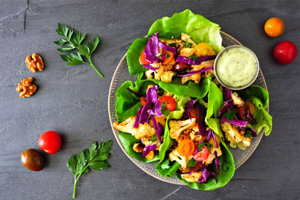How to achieve a healthy diet on a budget?
Discover how to maintain a nutritious diet without overspending Our guide provides practical strategies for budget-friendly meal planning and smart choices, ensuring you can enjoy healthy eating without breaking the bank
How to achieve a healthy diet on a budget? Maintaining a nutritious and balanced diet doesn't have to strain your finances. Eating well while being mindful of your budget is not only achievable but also a smart and sustainable choice. In this guide, we will explore practical strategies, budget-friendly meal planning, and tips for making the most of your resources, all while prioritizing your health. Discover how to enjoy nourishing meals without breaking the bank, making healthy eating an accessible reality for everyone.

Strategies for Eating Healthy on a Budget
1. Budget-Friendly Grocery Shopping
When it comes to maintaining a healthy diet on a budget, savvy grocery shopping is the first step. Here are some tips to help you make the most of your shopping trips while keeping costs in check:
Make a Shopping List
Before you head to the store, create a detailed shopping list based on your meal plan. This list will help you stay focused and avoid impulsive purchases. Be sure to include essential items like whole grains, lean proteins, fruits, and vegetables.
Compare Prices
Don't settle for the first option you see on the shelf. Take a moment to compare prices, especially when it comes to staple items like rice, pasta, and canned goods. Opt for store brands or generic products, which are often more budget-friendly without compromising quality.
Utilize Coupons and Discounts
Check for coupons and discounts before heading to the store. Many grocery stores offer digital coupons and loyalty programs that can significantly reduce your expenses. Additionally, keep an eye out for weekly sales and promotions on healthy food items.
Buy in Bulk
Consider purchasing non-perishable items, like rice, beans, and whole grains, in bulk. Buying in larger quantities can result in cost savings over time. Just ensure that you have adequate storage space to prevent food wastage.
Avoid Shopping When Hungry
Shopping on an empty stomach can lead to impulsive purchases and less mindful spending. Eat a small, healthy snack before heading to the store to maintain better control over your choices and budget.
Plan Meals Around Sales
Take advantage of weekly sales and discounts by planning your meals based on the available deals. This approach allows you to adapt your menu to budget-friendly ingredients while keeping your meals nutritious and delicious.
By implementing these strategies for budget-friendly grocery shopping, you can make your money go further while still being able to fill your cart with healthy and nourishing foods.
2. Meal Planning and Prepping
Effective meal planning and prepping are essential for maintaining a healthy diet on a budget. By following these steps, you can optimize your food choices and minimize waste:
Create a Weekly Meal Plan
Start by planning your meals for the week. Identify your main dishes, sides, and snacks, and ensure they include a balance of proteins, whole grains, fruits, and vegetables. A meal plan helps you stay organized and avoid spontaneous, less budget-friendly food choices.
Use Leftovers Wisely
When cooking, prepare extra portions to enjoy as leftovers. This practice reduces the need for cooking from scratch every day, saving both time and money. Make sure to store leftovers properly to maintain their freshness.
Prep Ingredients in Advance
Set aside some time each week for ingredient preparation. Wash, chop, and store fruits and vegetables, so they're readily available when you need them. Prepping in advance can make meal assembly quick and convenient, encouraging healthier choices.
Shop with Your Meal Plan in Mind
Stick to your meal plan when shopping, ensuring you only purchase items that align with your planned meals. This approach minimizes impulse buying and keeps your budget in check. Be flexible and open to using alternative ingredients if you find better deals in-store.
Minimize Food Waste
Be conscious of food expiration dates and aim to use ingredients before they go to waste. Additionally, use your freezer to store excess items, such as fruits and vegetables, to prevent spoilage and extend their shelf life.
Invest in Reusable Containers
Invest in a set of reusable food storage containers to safely store prepped ingredients and leftovers. This will not only reduce waste but also save you money in the long run by reducing the need for disposable storage solutions.
By incorporating these meal planning and prepping strategies, you can simplify your daily eating routine, reduce the likelihood of costly dining out, and ensure that you always have nutritious, budget-friendly options readily available.
3. Affordable Nutrient-Rich Foods
Eating nutrient-rich foods doesn't have to break the bank. Here are some cost-effective yet highly nutritious options to include in your budget-friendly diet:
Beans and Legumes
Beans, lentils, and peas are excellent sources of plant-based protein, fiber, and essential vitamins and minerals. They're not only budget-friendly but also versatile, making them a staple in economical, nutrient-rich meals like soups, stews, and salads.
Whole Grains
Whole grains like brown rice, oats, and whole wheat pasta are affordable and packed with fiber, which aids digestion and keeps you feeling full. They are the foundation of many healthy, budget-conscious meals and can be incorporated into various dishes.
Seasonal Fruits and Vegetables
Fruits and vegetables that are in season tend to be more affordable and fresher. They provide essential vitamins and antioxidants. Explore local farmers' markets and discount grocers for great deals on fresh produce.
Canned and Frozen Produce
Canned and frozen fruits and vegetables are convenient and often less expensive than fresh ones. They retain their nutritional value and have a longer shelf life, making them smart choices for those on a budget.
Lean Proteins
Opt for budget-friendly, lean protein sources like chicken, turkey, and eggs. These proteins are versatile and can be used in various recipes, providing essential amino acids for muscle and tissue repair.
Dairy Alternatives
If you're looking to cut costs on dairy, consider alternatives like almond or soy milk. These options are often competitively priced and fortified with nutrients such as calcium and vitamin D.
By incorporating these affordable, nutrient-rich foods into your diet, you can maintain a balanced and healthy eating plan while managing your expenses. These options offer both nourishment and value for your budget.
4. Cooking on a Budget
Cooking your meals at home is one of the most effective ways to maintain a healthy diet on a budget. Explore these strategies to make cooking affordable and nutritious:
Plan Budget-Friendly Recipes
Look for recipes that feature budget-friendly ingredients, such as beans, rice, and seasonal vegetables. Online resources and cookbooks offer a wealth of affordable meal ideas that cater to a tight budget.
Buy in Bulk and Store Smart
Purchasing staple items in bulk can save you money over time. Consider buying larger quantities of grains, canned goods, and other non-perishable items. Invest in proper storage containers to keep your ingredients fresh and prevent waste.
Cook in Batches
Batch cooking allows you to prepare several servings at once, which can be stored for future meals. This method not only saves time but also encourages cost-effective and healthier choices compared to dining out or ordering takeout regularly.
Limit Dining Out
Reducing the frequency of dining out or ordering food can significantly impact your budget. While it's enjoyable on occasion, it can be expensive in the long run. Allocate dining out as an occasional treat rather than a regular habit.
Experiment with Spices
Spices and herbs can transform simple, budget-friendly ingredients into flavorful dishes. Experiment with different spice combinations to add variety to your meals without increasing costs. Building a collection of essential spices can enhance your culinary creativity.
Embrace Leftovers
Don't underestimate the potential of leftovers. They provide a quick and cost-effective solution for lunch or dinner. You can also repurpose them into new dishes, reducing food waste and saving money in the process.
Cooking on a budget doesn't mean sacrificing taste or nutrition. By following these strategies, you can enjoy delicious, home-cooked meals that are kind to both your wallet and your health.
5. Avoiding Costly Pitfalls
When striving for a healthy diet on a budget, it's important to be aware of potential pitfalls that could lead to unnecessary expenses. Here's how to steer clear of costly mistakes:
Avoid Impulse Buying
Impulse buying often leads to overspending. To prevent this, stick to your shopping list and avoid adding items to your cart that weren't part of your planned meals. This practice can help you stay on budget and make healthier choices.
Limit Dining Out
While dining out can be a pleasant experience, it can quickly drain your budget if done frequently. Reserve dining out for special occasions and focus on preparing meals at home for your everyday nutrition needs.
Beware of Convenience Foods
Convenience foods, while easy, can be expensive and lack the nutrition your body needs. Frozen meals, fast food, and pre-packaged snacks often cost more than homemade alternatives and can be less healthy. Opt for homemade versions whenever possible.
Watch for Sales and Coupons
Take advantage of sales and coupons to maximize your savings. However, be cautious not to be swayed by discounts on items that aren't part of your planned meals. Stick to your list and only buy items that contribute to your healthy diet.
Don't Overbuy Perishables
Be mindful of the shelf life of perishable items like fruits, vegetables, and dairy products. Overbuying can result in food waste and wasted money. Buy what you can reasonably consume before items spoil.
Track Your Expenses
Maintain a budget and track your food expenses to ensure you're staying within your financial limits. Monitoring your spending can help you identify areas where you may need to adjust and make more budget-conscious choices.
Avoiding costly pitfalls is crucial in maintaining a healthy diet on a budget. By being mindful of your spending habits and making informed choices, you can achieve your dietary goals without compromising your financial well-being.
FAQs: Eating Well Without Breaking the Bank
Q1: How can I save money while buying healthy groceries?
A1: You can save money on healthy groceries by creating a shopping list, comparing prices, utilizing coupons, buying in bulk, and choosing store brands. Planning your meals and avoiding impulse buying are key steps to budget-friendly grocery shopping.
Q2: What's the benefit of meal planning when eating on a budget?
A2: Meal planning helps you organize your meals, minimize food waste, and stick to your budget. It allows you to choose budget-friendly ingredients and reduces the need for dining out, making eating well more affordable.
Q3: Which affordable foods are nutrient-rich and good for a budget-friendly diet?
A3: Affordable nutrient-rich foods include beans, whole grains, seasonal fruits and vegetables, canned and frozen produce, lean proteins like chicken and eggs, and dairy alternatives like almond or soy milk. These options offer essential nutrients while being kind to your budget.
Q4: How can I make cooking on a budget enjoyable and easy?
A4: You can make cooking on a budget enjoyable by exploring budget-friendly recipes, buying in bulk, batch cooking, limiting dining out, experimenting with spices, and embracing leftovers. These strategies simplify meal preparation and enhance your culinary experience.
Q5: What are some costly pitfalls to avoid when eating well on a budget?
A5: Costly pitfalls include impulse buying, frequent dining out, relying on convenience foods, overspending during sales, and overbuying perishables. Being mindful of these mistakes can help you maintain a healthy diet within your budget.
Q6: Is it possible to eat out on a budget while still making healthy choices?
A6: Yes, it's possible to eat out on a budget and make healthy choices. Look for restaurants with budget-friendly menus, opt for smaller portions, and avoid add-ons or extras that can inflate the cost of your meal. Balance dining out with home-cooked meals to save money.
Q7: How can I use leftovers effectively in my budget-conscious meal planning?
A7: To use leftovers effectively, incorporate them into new meals or repurpose them creatively. For example, turn last night's roasted vegetables into a frittata or use leftover chicken to make a sandwich or salad. This reduces food waste and stretches your budget further.
Q8: What's the role of mindful eating in maintaining a budget-friendly diet?
A8: Mindful eating involves savoring each bite, which can help you appreciate your meals and reduce the urge to overeat or spend money on additional snacks. Eating slowly and appreciating your food contributes to a more budget-conscious and healthy eating experience.
Q9: How can I make the most of sales and discounts while grocery shopping?
A9: To maximize sales and discounts, plan your meals around them, look for digital coupons, and consider signing up for loyalty programs. Be cautious not to buy items solely because they are on sale; stick to your planned groceries to stay on budget.
Q10: What are the essential kitchen tools for cooking on a budget?
A10: Essential kitchen tools for cooking on a budget include a good knife, cutting board, measuring cups and spoons, pots and pans, and food storage containers. These tools are versatile and make budget-friendly meal preparation more efficient.
Previous: Are there diet tips for maintaining healthy skin?
Next: last page










